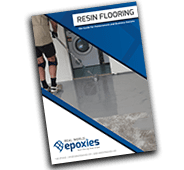Home › Advice › Know How › Knowhow
Optimising the Stone-look Flake System
Having completed a test installation of a new stone-look design, it was time to optimise the process -
from manufacturing the flake through to installing the system.
In this video I discuss some of the work that has gone into developing the new stone-look flake flooring:
Below is a photo of a finished floor using the new stone-look flake. I think it looks really clean and modern; much better than the
"70's vinyl" look you get from the 6mm (1/4 inch) flake. What do you think?

Video Transcription:
Acrylic flake or vinyl flake is very common. It's a bread and butter product line for most resin flooring guys, and everyone is familiar with the traditional six millimeter quarter inch flake blends.
Now, where the trend in flake is going is changing up from that '70s vinyl-looking' floor and there's some pretty clever things being done around what they call a stone look.
I like the idea of the stone look. I did a floor and I made a video where I did a stone looking floor where I'd been prototyping this type of flake.
I really like the idea. I think it's got great potential, but it's been difficult to manufacture. It's been painful process to put together and costly. My way of thinking is that's a problem in our industry and until we can make that more efficient, we're just not going to get the take-up of that stone look that I think we should have.
My development work is around a system of stone look flooring system, how to go about installing it but also how to go about manufacturing it in a cost-effective, process-efficient way with minimal losses and having a simple clean up.
To give you a little bit of insight, I'll show you what I've been doing and see if that sparks some interest and if you have any questions. I'll run you through some of the work that I've been doing.
Like I said, everyone is familiar with this style of flake finish, 6 millimeters or a quarter inch. You're basically putting together blends of different individual colors and you create a slightly different look, and you can use every colour of the spectrum if you like.
Here, we just have three simple examples. Now, the stone look is more like this sort of look. The contrast of colors is becoming much more subtle as you can see between the two boards. I like the look of it. It's also a slightly softer texture. It's not quite as profiled as the vinyl flake, which does mean that you need to be better on the base and the application. But that's just technique related.
The process of coming up with colours and the process of manufacturing it is the challenge. Even though I'm at the point where I'm pretty happy with these six color combinations of this new stone look, to get there is quite the task.
If I show you my R&D individual containers, this is the second lot that's left over. I had the same amount the first time, and here we are to the final 10.
So, there's a lot of work required to go through the process of developing a new range colour wise. Then the next step is the manufacturing of that flake and then incorporating it into a flooring system that is reproducible to get the same look every time across any sized floor.
That's some of the development work I'm playing with. I'm Resin Jack. As always, take care and keep smiling.
-
Products - Use quality resins and flake that are designed to get the best possible stone-look finish:
- Ezypoxy Rollcoat - Tintable Epoxy Rollcoat
- Ezypoly - One-pack, Moisture-cured Polyurethane
- Resin Granite Flake - Coloured Flake Chips
-
Systems - Specify specialist stone-look flake flooring systems with proven performance:
- Resin Granite - Decorative Flake Flooring System
-
Learning - Learn more about flake flooring in general with our online courses:
- Epoxy Flooring How To Videos
- Epoxy Flooring Short Courses
- Garage Granite Installation Course
- Bronze Card Course
- Silver Card Course
-
Ask a question - If you have any questions you'd like to ask us about this topic, hit the support button below:
_800x270a.png)
